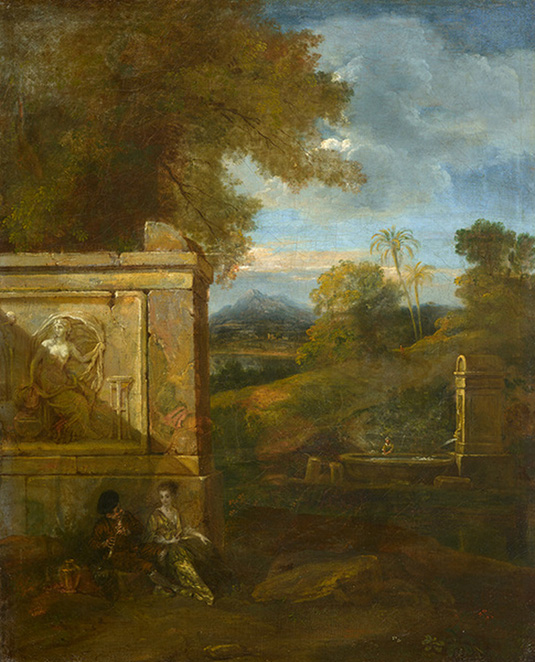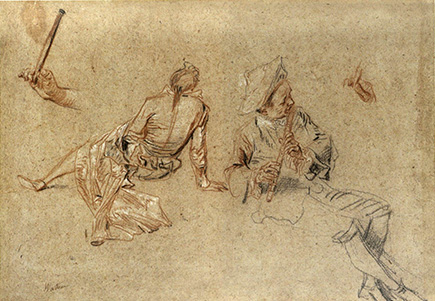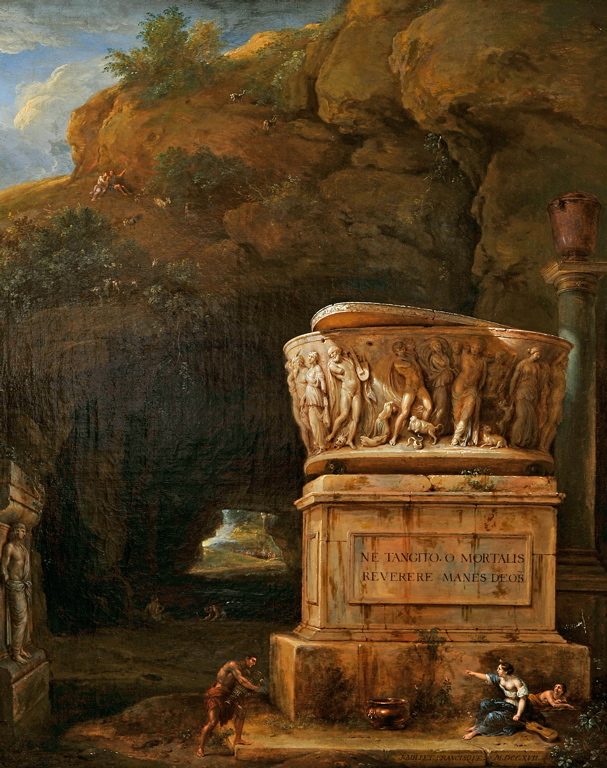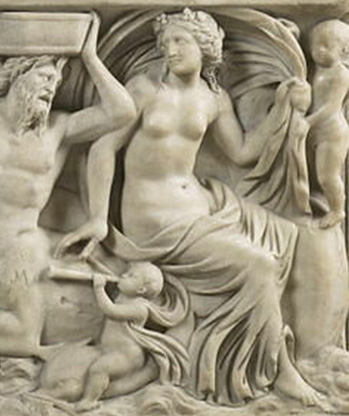
- Home Page
- Accepted
Paintings & Copies - Doubtful
Attributions - Doubtful Textual References
- Alternative
Titles - Collectors &
Museums - Bibliography
- Search Abecedario
- Watteau &
His Circle
Le Flûtiste
Entered July 2022; revised August 2022

Grenoble, Musée de Grenoble-J.L. Lacroix, inv. MG 186
Oil on canvas
55 x 45.2 cm
ALTERNATIVE TITLES
The Flute Player
Le Joueur de flûte
Paysage
Paysage au flûtiste
Paysage avec figures
Paysage italianisant avec un tombeau et une fontaine, au premier plan une femme et un homme jouant de la flûte
RELATED PRINTS
The painting was not engraved for Jean de Jullienne’s Oeuvre gravé.
PROVENANCE
Paris, collection of Jean-Baptiste Guillaume de Gevigney (1729-1802; Généalogiste au service du comte de Provence, Garde des titres et généalogies de la Bibliothèque du Roi). His sale, Paris, December 1-29, 1779, lot 30: “BOYER ET WATTEAU . . . Un Paysage, à la gauche duquel est un grand pied-d’estal où l’on voit un bas-relief dans le genre antique, & sur un plan éloigné une Fontaine où une femme lave du linge: le devant de ce tableau est orné d’une figure d’homme qui joue de la flûte, & près de lui est une femme. Hauteur 22 pouces, largeur 15 pouc. & demi. Sur toile.” Sold for 33 livres to Alexandre Joseph Paillet, according to an annotated copy of the sale catalogue in the Bibliothèque nationale, Paris.
Paris, unidentified merchant on the quai des Théatins. He sold it to Jacques Louis Jay in 1799 for 60 francs: “un paysage où sont deux figures assises près d’un monument antique par Vatteau.”
EXHIBITIONS
Paris, Musée Carnavalet, Chefs-d'oeuvres des musées de province (1933), cat. 116.
Paris, Petit Palais, Chefs-d'oeuvres du Musée de Grenoble (1935), cat. 116 (as by Watteau and Francisque Millet or Michel Boyer, Le Joueur de flûte dans un paysage).
London, Royal Academy, Landscape in French Art (1949), cat. 78 (attributed to Jean Antoine Watteau, The Flute Player, lent by the Musée de Grenoble).
Paris, Galerie Charpentier, Plaisir de France (1951), cat. 197 (Watteau and Francisque Millet or Michel Boyer, Le Joueur de flûte, lent by the Musée de Grenoble).
Arras, Musée, Rubens contre Poussin (2004), cat. 26 (as by Watteau and Francisque [sic], Paysage au flûtiste, lent by the Musée des beaux-arts de Grenoble).
Paris, Grand Palais. Mélancolie: génie et folie (2005)
Paris, Jacquemart-André,Watteau à Fragonard (2014), cat. 12 (as by Jean [sic] Millet et Antoine Watteau, Paysage italianisant avec un tombeau et une fontaine, au premier plan une femme et un homme jouant de la flûte, lent by the Musée de Grenoble).
Eidelberg, Rêveries italiennes (2015), 65 (as by Francisque Millet fils and Watteau, Le Flûtiste, lent by Grenoble, Musée des beaux-arts).
SELECT BIBLIOGRAPHY
Notice des tableaux des écoles française (1801).
Grenoble, Musée des beaux-arts, Catalogue des tableaux (1844), cat. 44.
Grenoble, Musée des beaux-arts, Notice des tableaux et objets (1856), cat. 179.
Clément de Ris, Les Musées de province (1872), 184.
Grenoble, Musée des beaux-arts, Notice des tableaux et objets (1874), cat. 265.
Grenoble, Musée des beaux-arts, Notice des tableaux et objets (1884), cat. 265.
Grenoble, Ville de Grenoble. Catalogue des tableaux (1891), cat. 229.
Grenoble, Ville de Grenoble. Catalogue des tableaux (1901), cat. 113.
Josz, Watteau (1904), 182.
Marcel, La Peinture française (1905), 291.
Beylie, Le Musée de Grenoble (1909), 88.
Zimmermann, Watteau (1912), pl. 155.
Pilon, Watteau et son école (1912), 130.
Nicolle, “Watteau dans les musées de province” (1921), 135.
Ingersoll-Smouse, Pater (1928), 7.
Ratel, “Visite au musée de Grenoble” (1929), 801.
Adhémar, Watteau (1950), cat. 73, 280.
Macchia and Montagni, L’opera completa di Watteau (1968), cat. 20-AA.
Eidelberg, “The Painters of the Grenoble 'Flutist'” (1969), 282-91.
Eidelberg, «Le Flutiste» (1978), 12-19.
Roland Michel, Watteau (1984), 300.
Rosenberg and Prat, Watteau, Catalogue raisonné des dessins (1996), cat. 536.
Chomer and Thuillier, Peintures françaises avant 1815 (2000), cat. 113.
Eidelberg, “The Case of the Vanishing Watteau” (2001), 17.
Michel, Le «célèbre Watteau» (2008), 139-40.
Glorieux, Watteau (2011), 242.
RELATED DRAWINGS

Watteau, Studies of a Reclining Man and a Flutist, red, black, and white chalk, 25 x 34 cm. Whereabouts unknown.
One of the drawings that Watteau used for Le Flûtiste has survived: a study of the flutist on a sheet together with one of a man reclining, seen from behind (Rosenberg and Prat 536). Lost from sight for a while, this drawing recently reappeared at auction (Paris, Piasa, November 21, 2001, lot 123). Watteau turned to the study of this musician on other occasions, namely for L’Assemblée dans un parc in the Louvre and for Le Lorgneur in the Virginia Museum of Fine Arts, Richmond, Virginia. Presumably he also depended on a drawing for the flutist’s female companion, but this has not survived.
REMARKS
Although we cannot identify the original owner of this painting in the early eighteenth century, we can trace the picture’s whereabouts from the last quarter of that century onward until the present. Its first known owner was the abbé de Gevigney, a collector who possessed a number of problematic pictures. At the sale of his collection in 1779 it was bought by the dealer Paillet, and then evidently passed directly or indirectly to a dealer on the quai des Théatins. In turn, this dealer sold it in 1799 to Jacques Louis Jay, who had been entrusted with funds to buy paintings for the newly-founded art museum in Grenoble. It has remained there ever since.
As will be discussed, the painting is a collaboration between Francisque Millet fils (1666-1723) and Watteau, and presumably some memory of that was retained for its first decades. But by the time the painting was auctioned in 1779, Francisque’s participation had been forgotten and, instead, the landscape portion was assigned to Michel Boyer. Twenty years later, when Jay bought the painting, it was attributed to Watteau alone; the participation of a second artist went unmentioned. Presumably this was because a painting executed by just Watteau was more valuable. And when the picture was in the museum, as the museum’s many catalogues demonstrate, this listing of a single author remained in place for several decades more. But by the 1844 catalogue the situation had changed dramatically. The 1844 catalogue listed the picture under the name of Francisque Millet fils, but it also stated “Les figures sont de Watteau.” The dual attribution was continued in the 1856 edition where it was noted that if the attribution to Watteau was correct, then the landscape was by Francisque Millet père. However, that reasoning makes no sense since Francisque père died in 1679, years before Watteau had even been born. The museum’s subsequent catalogues, such as those of 1874, 1879, 1884, and 1909, as well as independent scholars such as Clément de Ris, Virgil Josz, and Pierre Marcel, continued the tradition of attributing the picture to Watteau and Francisque fils. Rarely were other opinions raised. Following the advice of scholar Georges Lafenestre, the direction of thought changed yet again in the late nineteenth century, and the 1891 and 1901 editions of the museum’s catalogue gave the whole of the painting to Watteau.
Alternatively, some critics wondered openly whether the landscape portion of the Grenoble picture was by Boyer or Francisque: the catalogues for the exhibitions in Paris in 1933, at the London Royal Academy in 1949, and in the Galerie Charpentier in 1951. Ingersoll-Smouse thought that the landscape had been executed by Boyer. Adhémar vacillated between Millet alone and a collaboration between him and Watteau, without coming to a conclusion. Having discovered that the painting was sold from the Gevigney collection in 1779, where the landscape was given to Boyer, I wrongly concluded that he was responsible for that portion of the painting, but then I corrected myself in 1978 where I came out in favor of Francisque.
Only occasionally did Watteau scholars reject all or part of the Grenoble painting, Zimmerman was one of those who broke ranks and denied the attribution to Watteau. He instead proposed that it was a picture of the late eighteenth century. Nicolle wrote that the attribution of the picture to Watteau did not inspire confidence, an oblique way of not accepting it. Macchia and Montagni noted Zimmerman’s rejection and though they listed the painting under works attributed to Watteau, they did not acknowledge that Watteau actually had a share in it.
Negative opinions notwithstanding, it is apparent that the Grenoble painting was a collaboration between Francisque Millet fils and Watteau. Watteau’s role is apparent, not least because of its relation to the drawing of the flutist. But also in its favor is the character of the woman—languid and graceful, emoting an incomparable hauteur and wistfulness. Here is Watteau’s genius.

Francisque Millet fils, Grotto with a Roman Tomb, oil on canvas, 73.5 x 60 cm. Senlis, Musée d’art et d’archéologie.
Francisque’s role is equally apparent. The Grenoble painting is remarkably close in composition to a slightly larger picture now in the museum in Senlis. Its image of a classical tomb on a high pedestal in the Roman campagna, enlivened by raking light, is a perfect match with the Grenoble picture. Most important, the Senlis painting is prominently signed “J Millet Francisque” and is dated 1717. This picture confirms beyond doubt the identity of the artist responsible for the landscape and sculpture in the Grenoble painting.
Although we are heavily dependent on the six biographies of Watteau written by his contemporaries, none of these texts mention Francisque’s name. But surviving documents shed some needed light on their possible links, many of which center on the activities of the Franco-Flemish community in Paris. Because Watteau’s natal city of Valenciennes had been part of the Spanish Netherlands until 1678, just some six years before his birth there, he was consistently termed “Flemish artist” by his Parisian contemporaries—even by his closest friends such as Jean de Jullienne and Pierre Crozat. As some of them carefully distinguished, Watteau was considered to be a French artist but he was not of French blood. Although Francisque was of French blood and was born in Paris, his French father had been born in Antwerp and thus when he returned to Paris he was associated with the Franco-Flemish community. In Paris, for example, Francisque fils was evidently a friend of the Franco-Flemish landscape painter Nicolas Platemontange (originally “van Plattenburg”). Not coincidentally, Nicolas’ sister Catherine was married to yet another Franco-Flemish painter in Paris, Philippe Vleughels, and he in turn was the father of Watteau’s very close friend, Nicolas. It was inconceivable that Watteau and Francisque would not have come into contact though these social links within the Franco-Flemish community. This is not merely a possibility but a probability; indeed, it is not merely conjuncture since the Grenoble painting is tangible proof that they did know and collaborate with each other.

Roman, Sarcophagus with Deities (detail). Paris, Musée du Louvre.
One of the remarkable aspects of the Grenoble paintings is that the Ancient sculpture that Francisque depicted in the landscape records an actual Roman monument, the result of knowledge he evidently gained in Italy. The figure on the pedestal depicts a nereid that Francisque saw on a Roman sarcophagus, one that in the seventeenth century was still in Rome. Francisque must have traveled to Italy and recorded these Classical monuments in drawings that brought back to Paris and later utilized for his paintings. Watteau never traveled to Italy, but he had expressed is desire to do so and twice (unsuccessfully) competed for the Prix de Rome. One can well imagine he and Francisque discussed the beauty of the Italian landscape and the abundance of Ancient ruins with great pleasure, even if for Watteau that pleasure was only secondhand. Although these artists worked a half century before Fragonard and Hubert Robert, they anticipated what was to come.